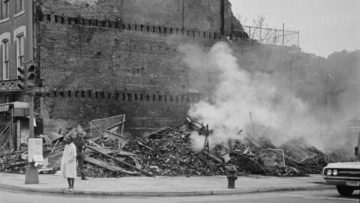Donovan X. Ramsey in Guernica:
 Especially in northern cities, Blacks were boxed into lives of poverty, redlined into areas of concentrated poverty and further isolated when the federal government built interstate highways that separated them from their white neighbors. Their neighborhoods were patrolled by police departments who moved like occupying forces, with extreme prejudice and impunity. In these places — Los Angeles, New York, Newark, Detroit, and other cities — police brutality was a regular occurrence.
Especially in northern cities, Blacks were boxed into lives of poverty, redlined into areas of concentrated poverty and further isolated when the federal government built interstate highways that separated them from their white neighbors. Their neighborhoods were patrolled by police departments who moved like occupying forces, with extreme prejudice and impunity. In these places — Los Angeles, New York, Newark, Detroit, and other cities — police brutality was a regular occurrence.
Those conditions birthed another movement. It existed alongside the same timeline as the Civil Rights Movement but wasn’t focused on inclusion and legal protection. It wanted power, the ability for Blacks to control their own lives and communities — including self-defense. This movement also excited Black America, segments that the Civil Rights Movement did not and in ways it couldn’t. The most prominent leader in this movement, of course, was Malcolm X who advocated for complete independence of Black Americans from a fundamentally wicked white society.
More here.
